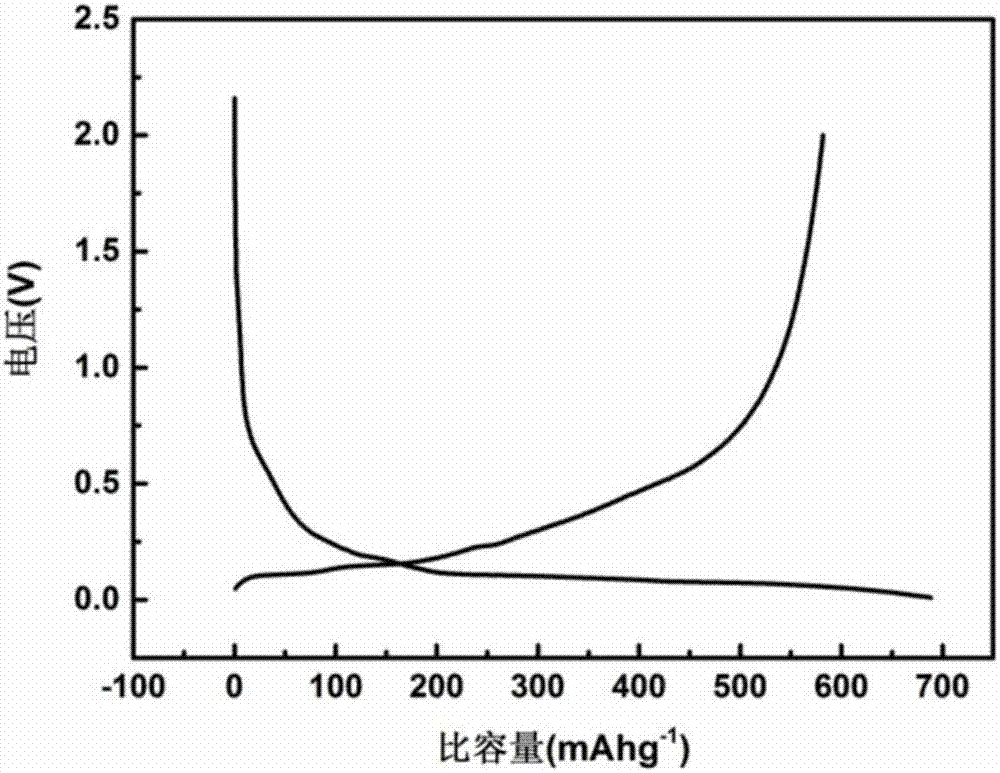Silicon-carbon composite material as well as preparation method and application thereof
A silicon-carbon composite material and carbonization technology, which is applied in nanotechnology, electrical components, electrochemical generators, etc. for materials and surface science, can solve problems such as slow structure destruction, achieve simple production process, reduce side reactions, The effect of excellent cycle stability
- Summary
- Abstract
- Description
- Claims
- Application Information
AI Technical Summary
Problems solved by technology
Method used
Image
Examples
Embodiment 1
[0040] A kind of silicon-carbon composite material of the present invention, its preparation method comprises the following steps:
[0041] S1. Preparation of Si@G material:
[0042] 1.1. Weigh 0.6g of nano-silicon and 0.1g of dispersant CTAB, disperse in 50ml of ethanol and sonicate for half an hour to obtain nano-silicon dispersion;
[0043] 1.2, weigh 0.3g lithium carbonate and 3g flake graphite, add in 60ml of ethanol and stir for 2h to obtain lithium carbonate / graphite dispersion;
[0044] 1.3. Add the nano-silicon dispersion liquid in step 1.1 dropwise into the lithium carbonate / graphite dispersion liquid dispersion liquid in step 1.2, stir for 2 hours and then ultrasonically treat for 40 minutes, (the working frequency of the ultrasonic cell disruptor is 22±1kHz) to obtain a uniform dispersion liquid;
[0045] 1.4. Vacuum filter the uniform dispersion in step 1.3 to obtain the filter residue, and dry the filter residue in a vacuum drying oven at 80°C;
[0046] 1.5. Put ...
Embodiment 2
[0056] A kind of silicon-carbon composite material of the present invention, its preparation method comprises the following steps:
[0057] S1, preparation of silicon-graphite lithium carbonate mixed solution:
[0058] 1.1. Weigh 0.6g of nano-silicon and disperse it in 50ml of deionized water to obtain a nano-silicon dispersion;
[0059] 1.2, Weigh 0.3g lithium carbonate and 3g flake graphite, add 100ml of deionized water to disperse to obtain lithium carbonate / graphite dispersion;
[0060] 1.3. Add the nano-silicon dispersion liquid in step 1.1 dropwise into the lithium carbonate / graphite dispersion liquid in step 1.2, and ball mill at a speed of 350 r / min for 1 h to obtain a lithium carbonate / silicon / graphite mixture.
[0061] S2. Preparation of precursor materials:
[0062] 2.1. Dissolve 1.5g glucose in 250ml deionized water to obtain glucose solution;
[0063] 2.2. Add the lithium carbonate / silicon / graphite mixture in step S1 dropwise to the glucose solution in step 2.1...
Embodiment 3
[0070] A kind of silicon-carbon composite material of the present invention, its preparation method comprises the following steps:
[0071] S1, preparation of silicon-graphite lithium carbonate mixed solution:
[0072] 1.1. Weigh 0.6g of nano-silicon and 3g of graphite flakes and mix them, and disperse them in 100ml of ethanol to obtain a silicon / graphite mixture;
[0073] 1.2, weigh 0.2g lithium carbonate and 0.1g agar, add 80ml of deionized water to obtain agar / lithium carbonate mixed solution;
[0074] 1.3. Add the agar / lithium carbonate mixture in step 1.2 into the silicon / graphite mixture in step 1.1, stir continuously, and sonicate for 2 hours (the working frequency of the ultrasonic cell disruptor is 22±1kHz) to obtain the lithium carbonate / silicon / graphite mixture liquid;
[0075] 1.4. Stir the lithium carbonate / silicon / graphite mixture in an oil bath at 80°C and evaporate to dryness, put the evaporated dry matter into a ball mill jar, under an argon atmosphere, with...
PUM
| Property | Measurement | Unit |
|---|---|---|
| current efficiency | aaaaa | aaaaa |
| current efficiency | aaaaa | aaaaa |
| current efficiency | aaaaa | aaaaa |
Abstract
Description
Claims
Application Information
 Login to View More
Login to View More - R&D
- Intellectual Property
- Life Sciences
- Materials
- Tech Scout
- Unparalleled Data Quality
- Higher Quality Content
- 60% Fewer Hallucinations
Browse by: Latest US Patents, China's latest patents, Technical Efficacy Thesaurus, Application Domain, Technology Topic, Popular Technical Reports.
© 2025 PatSnap. All rights reserved.Legal|Privacy policy|Modern Slavery Act Transparency Statement|Sitemap|About US| Contact US: help@patsnap.com


